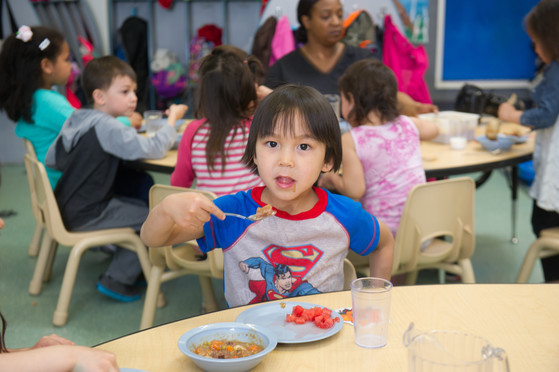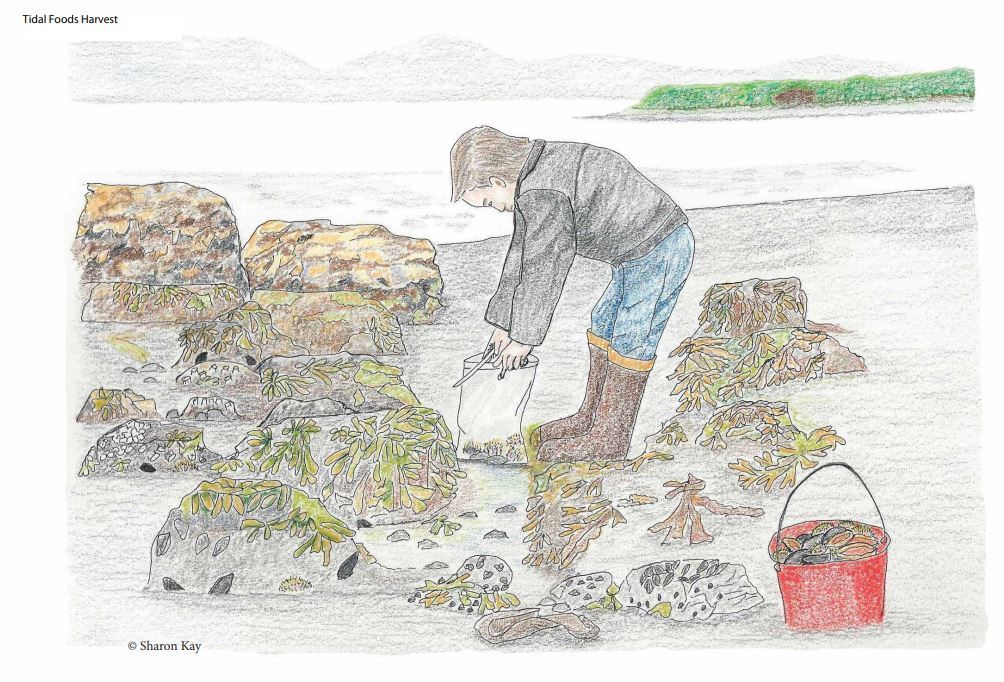
Celebrating what's served on the plate: Serving the youngest Alaskans local, traditional foods
June 1, 2022 — Children as young as 3, 4 and 5 eat duck soup for lunch at King Cove’s Head Start. In Chevak, these preschoolers eat caribou stew. In the Bristol Bay Borough School District, the little ones’ families sit at the table to eat traditional foods together.
That’s how child care and preschool programs are introducing Alaska foods and traditions to children at very early ages. That helps kids learn about and celebrate their cultures, and at the same time serves nutritious meals to children who are still exploring food and drink options.
Young children feel their best when served healthy foods and drinks with little or no added sugars, and traditional Alaska foods meet that need. Serving local, regional foods to children as early as possible can help them learn to love eating these healthy foods for the rest of their lives.

Children at Cook Inlet Head Start in Anchorage enjoy reindeer stew for lunch.
Traditional foods have become less familiar to children
Tracy Stewart is the Traditional Foods Program Coordinator with the Aleutian Pribilof Islands Association (APIA). According to Stewart, a survey conducted by APIA in 2002 showed a decline in the use of traditional foods, while obesity and diabetes increased.
Traditional Alaska foods — such as fish, wild game and berries — are great sources of nutrients and healthy fats with no added sugars. Store-bought foods, on the other hand, are often highly processed with lower amounts of nutrients and higher amounts of unhealthy fats and sugars.
“The nutritional value and benefit from traditional foods is important for the people in the region,” said Sue Unger, Wellness Lead at APIA. “It’s important for them to get healthy foods.”
Stewart and Unger helped develop a traditional food curriculum for its Head Start programs.
“We got feedback from the Head Start programs that a lot of the nutritional materials that were being used weren’t applicable to our region,” Stewart said. “It would give examples of a star fruit or a passion fruit, something that these kids had no access to and had never seen before.”
Fish, however, is available at all Head Start sites in Stewart’s region, so she includes fish on lunch plates and in lesson plans.
“The kids have really enjoyed the salmon unit and doing projects with them, like painted fish prints,” Stewart said.

Artwork for the Qaqamiiĝux̂ Head Start Traditional Food for Preschoolers Curriculum, by Sharon Kay
Cultural, nutrition-focused education looks different everywhere it’s taught
Learning about traditional foods is as important as eating them. Child care programs across Alaska have created lesson plans that feature foods that are important in their regions.
Lea Palmer is the Dietitian and Food Service Lead with the Rural Alaska Community Action Program, Inc. (RurAL CAP) Head Start Program. They are trying their new Got Neqpiaq Traditional Foods Head Start Curriculum at 12 Head Start sites this year.
“I love that this curriculum teaches children about healthy living in a way that is culturally relevant,” Palmer said. “Healthy living does not have to look the same for everyone. Every culture has healthy aspects. When those healthy traditional lifestyles are embraced in lessons, young children can develop healthy habits that will not only support their growth and development, but also help them develop a sense of connection to cultural values, community, and family, and a sense of self-identity.”
RurAL CAP’s Got Neqpiaq, which means “Got Real Food,” curriculum focuses on healthy, traditional living in the Yukon-Kuskokwim region. Each themed unit teaches Head Start students the importance of eating healthy subsistence foods, staying active with traditional dancing and games, learning from family and elders, and connecting to cultural values.
In the Aleutian Pribilof Islands region, Unger joined elders, community leaders and local traditional food experts to write a book to help preserve local traditional food knowledge and improve people’s health. Qaqamiiĝux̂ — which means “to hunt or fish for food and collect plants” or “subsistence” —includes information on harvesting, preserving, and nutritional facts, as well as recipes using foods of the Aleutian region. This book and information is the basis for the Qaqamiiĝux̂ Head Start Traditional Food for Preschoolers Curriculum. Each lesson focuses on a local plant or animal and includes a poster showing how that food is harvested and preserved, fun activities, stories, and the Aleut “unangam tunuu” (language) and “unangax” (values).
In the Bristol Bay Borough School District, Esther Pepin is working on a new curriculum for their Yup'ik and Dena'ina preschoolers. Pepin, the Early Childhood Director, said the district is designing meaningful play materials, such as small-sized plexiglass and wood ulus.
“The felt fish we were able to make with a 3-D printer are a big hit with the kids,” said Pepin.
Child care sites and schools must meet the Alaska Food Safety and Sanitation Program requirements and guidelines for serving traditional foods, including how foods should be harvested, prepared and stored. Many traditional foods must be donated, not purchased, so programs work with community members to get the donated foods they need.
Learn more through Alaska traditional food resources
There are many resources to help child care providers teach young children about traditional Alaska foods:
-
The Wellness Guide for Alaska’s Young Children has a section on including traditional foods for child care providers.
- The Women, Infants, and Children Program (WIC) has a “Tundra to Table” video and mini-magazine series featuring blueberries, cranberries, fiddlehead ferns, fireweed, rhubarb, salmonberries and sourdock.
- The Alaska Native Tribal Health Consortium Wellness Program has The Store Outside Your Door video series that highlights harvesting and cooking traditional foods from around the state.
- The Alaska Department of Fish & Game has information and lessons on Alaska’s wild animals and fish for early childhood teachers.
|